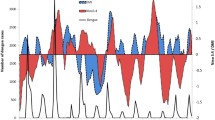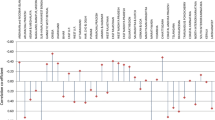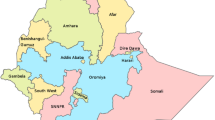Abstract
An effort is made to understand the role of El Nino-Southern Oscillation (ENSO) and Indian Ocean Dipole (IOD) events on the malaria transmission intensity over India during the period 1951–2020 (70 years) with the help of a realistically simulated dynamical malaria model. The results suggest that the La Nina years pose a greater threat of malaria disease, especially in the densely populated Indian states. During El Nino years, the malaria transmission intensity and distribution over India greatly reduce, except in the regions such as Orissa, Chhattisgarh, Jharkhand, Western Ghats, parts of Madhya Pradesh, and Andhra Pradesh. It is found that in the positive IOD years, the malaria transmission intensity increases (decreases) over the entire central Indian region and along coastal regions of Tamil Nadu and Kerala (southern peninsular states of India and northeast India). An almost opposite behavior is seen during the negative IOD years. The malaria transmission variability over India is becoming increasingly heterogeneous in recent decades during the El Nino and La Nina years as a result of global warming. The period of 1986–2020 witnessed a substantial decrease (increase) in the malaria transmission intensity during the positive (negative) IOD years, except for a few regions of India. The implications of the results presented in the paper linking the ENSO and IOD signals with the intensity and distribution of malaria over India in a warming world are enormous, especially for the densely populated Indian states.




Similar content being viewed by others
Data availability
The ERA5 reanalysis air temperature data (https://www.ecmwf.int/en/forecasts/datasets/reanalysis-datasets/era5), and IMD rainfall dataset (https://www.imdpune.gov.in/Clim_Pred_LRF_New/Grided_Data_Download.html) used in this study are freely available for research purpose.
References
Abiodun GJ, Maharaj R, Witbooi P, Okosun KO (2016) Modelling the influence of temperature and rainfall on the population dynamics of Anopheles arabiensis. Malar J 15(1):1–15
Anyamba A, Chretien JP, Britch SC, Soebiyanto RP, Small JL, Jepsen R, Forshey BM, Sanchez JL, Brett M, Jose L, Smith RD, Harris R, Tucker CJ, Karesh WB, Linthicum KJ (2019) Global disease outbreaks associated with the 2015–2016 El Niño event. Sci Rep 9(1):1–14
Balk D, Pozzi F, Yetman, G, Deichmann, U, Nelson A (2005) The distribution of people and the dimension of place: methodologies to improve the global estimation of urban extents In: International Society for Photogrammetry and Remote Sensing, proceedings of the urban remote sensing conference, pp 14–16
Behera SK, Ratnam JV (2018) Quasi-asymmetric response of the Indian summer monsoon rainfall to opposite phases of the IOD. Sci Rep 8(1):1–8
Behera SK, Yamagata T (2001) Subtropical SST dipole events in the southern Indian Ocean. Geophys Res Lett 28(2):327–330
Behera SK, Morioka Y, Ikeda T, Doi T, Ratnam JV, Nonaka M, Tsuzuki A, Imai C, Kim Y, Hashizume M, Iwami S, Kruger P, Maharaj R, Sweijd N, Minakawa N (2018) Malaria incidences in South Africa linked to a climate mode in southwestern Indian Ocean. Environ Dev 27:47–57
Bhattacharya S, Sharma C, Dhiman RC, Mitra AP (2006) Climate change and malaria in India. Curr Sci 90(3):369–375
Boschat G, Simmonds I, Purich A et al (2016) On the use of composite analyses to form physical hypotheses: an example from heat wave-SST associations. Sci Rep 6:29599. https://doi.org/10.1038/srep29599
Bouma MJ, van der Kaay HJ (1996) The EI Niño Southern Oscillation and the historic malaria epidemics on the Indian subcontinent and Sri Lanka: an early warning system for future epidemics? Tropical Med Int Health 1(1):86–96
Bouma MJ, Siraj AS, Rodo X, Pascual M (2016) El Niño-based malaria epidemic warning for Oromia, Ethiopia, from August 2016 to July 2017. Tropical Med Int Health 21(11):1481–1488
Castro MC (2017) Malaria transmission and prospects for malaria eradication: the role of the environment. Cold Spring Harb Perspect Med 7(a025601):1–12
Chaturvedi S, Dwivedi S (2020) Estimating the malaria transmission over the Indian subcontinent in a warming environment using a dynamical malaria model. J Water Health 18(3):358–374
Chaturvedi S, Dwivedi S (2021) Understanding the effect of climate change in the distribution and intensity of malaria transmission over India using a dynamical malaria model. Int J Biometeorol 65(7):1161–1175
Chaves LF, Satake A, Hashizume M, Minakawa N (2012) Indian Ocean Dipole and rainfall drive a Moran effect in East Africa malaria transmission. J Infect Dis 205(12):1885–1891
Dhiman RC, Sarkar S (2017) El Niño Southern Oscillation as an early warning tool for malaria outbreaks in India. Malar J 16(1):1–7
Dwivedi S (2012) Forecasting the peak anomalies of dominant intrinsic modes of Indian Ocean Dipole. Deep Sea Res Part I Oceanogr Res Papers 70:73–82. https://doi.org/10.1016/j.dsr.2012.10.005
Dwivedi S, Goswami BN, Kucharski F (2015) Unraveling the missing link of ENSO control over the Indian monsoon rainfall. Geophys Res Lett 42:8201–8207
Dwivedi S, Pandey P, Goswami BN (2022) Nonstationarity and Potential Multi-Decadal Variability in Indian Summer Monsoon Rainfall and Southern Annular Mode Teleconnection. Clim Dyn 59:671–683
Gething, P., Van Boeckel, T., Smith, D., Guerra, C., Patil, A., Snow, R., & Hay, S. (2011). Modelling the global constraints of temperature on transmission of Plasmodium falciparum and P. vivax. Parasit Vectors, 4, 92.
Harp, R. D., Colborn, J. M., Candrinho, B., Colborn, K. L., Zhang, L., & Karnauskas, K. B. (2021). Interannual climate variability and malaria in Mozambique. GeoHealth, 5(2), e2020GH000322.
Hashizume M, Terao T, Minakawa N (2009) The Indian Ocean dipole and malaria risk in the highlands of western Kenya. Proc Natl Acad Sci 106(6):1857–1862
Hashizume M, Chaves LF, Minakawa N (2012) Indian Ocean Dipole drives malaria resurgence in East African highlands. Sci Rep 2(1):1–6
Hersbach H et al (2020) The ERA5 global reanalysis. Q J R Meteorol Soc 146(730):1999–2049
Kilian AH, Langi P, Talisuna A, Kabagambe G (1999) Rainfall pattern, El Nino and malaria in Uganda. Trans R Soc Trop Med Hyg 93:22–23
Kovats RS (2000) El Niño and human health. Bull World Health Organ 78:1127–1135
Kovats RS, Bouma MJ, Hajat S, Worrall E, Haines A (2003) El Nino and Health. Lancet 362:1481–1489
Leedale J, Tompkins AM, Caminade C, Jones AE, Nikulin G, Morse AP (2016) Projecting malaria hazard from climate change in eastern Africa using large ensembles to estimate uncertainty. Geospat Health 11:102–114
Lindblade KA, Walker ED, Onapa AW, Katungu J, Wilson ML (1999) Highland malaria in Uganda: prospective analysis of an epidemic associated with El Nino. Trans R Soc Trop Med Hyg 93:480–487
Lindsay SW, Bodker R, Malima R, Msangeni HA, Kisinza W (2000) Effect of 1997–98 El Nino on highland malaria in Tanzania. Lancet 355:989–990
Loevinsohn ME (1994) Climatic warming and increased malaria incidence in Rwanda. Lancet 343:714–718
Mordecai EA, Paaijmans KP, Johnson LR, Balzer C, Ben-Horin T, Moor E, McNally A, Pawar S, Ryan SJ, Smith TC et al (2013) Optimal temperature for malaria transmission is dramatically lower than previously predicted. Ecol Lett 16:22–30
Paaijmans KP, Wandago MO, Githeko AK, Takken W (2007) Unexpected high losses of Anopheles gambiae larvae due to rainfall. Plos One 2:e1146
Paaijmans KP, Cator LJ, Thomas MB (2013) Temperature-dependent pre-bloodmeal period and temperature-driven asynchrony between parasite development and mosquito biting rate reduce malaria transmission Intensity. Plos One 8(1):e55777
Pai DS, Rajeevan M, Sreejith OP, Mukhopadhyay B, Satbha NS (2014) Development of a new high spatial resolution (0.25× 0.25) long period (1901–2010) daily gridded rainfall data set over India and its comparison with existing data sets over the region. Mausam 65(1):1–18
Pandey P, Dwivedi S, Goswami BN, Kucharski F (2020) A new perspective on ENSO-Indian summer monsoon rainfall relationship in a warming environment. Clim Dyn 55(11):3307–3326
Rayner NA, Parker DE, Horton EB, Folland CK, Alexander LV, Rowell DP, Kent EC, Kaplan A (2003) Global analyses of sea surface temperature, sea ice, and night marine air temperature since the late nineteenth century. J Geophys Res: atmos 108(D14)
Saji NH, Yamagata T (2003) Possible impacts of Indian Ocean dipole mode events on global climate. Clim Res 25(2):151–169
Saji NH, Goswami BN, Vinayachandran PN, Yamagata T (1999) A dipole mode in the tropical Indian Ocean. Nature 401(6751):360–363
Sarkar S, Gangare V, Singh P, Dhiman RC (2019) Shift in potential malaria transmission areas in India, using the fuzzy-based climate suitability malaria transmission (FCSMT) model under changing climatic conditions. Int J Environ Res Public Health 16(18):3474. https://doi.org/10.3390/ijerph16183474
Singh Parihar R, Bal PK, Kumar V, Mishra SK, Sahany S, Salunke P, Dash SK, Dhiman RC (2019) Numerical modeling of the dynamics of malaria transmission in a highly endemic region of India. Sci Rep 9(1):1–9
Singh N, Sharma VP (2002) Patterns of rainfall and malaria in Madhya Pradesh, central India. Ann Trop Med Parasitol 96:349–359
Smith J, Tahani L, Bobogare A, Bugoro H, Otto F, Fafale G, Hiriasa D, Kazazic A, Beard G, Amjadali A, Jeanne I (2017) Malaria early warning tool: linking inter-annual climate and malaria variability in northern Guadalcanal. Solomon Isl Malar J 16(1):1–16
Thomson M, Indeje M, Connor S, Dilley M, Ward N (2003) Malaria early warning in Kenya and seasonal climate forecasts. Lancet 362(9383):580
Thomson M, Mason SJ, Phindela T, Connor SJ (2005) Use of rainfall and sea surface temperature monitoring for malaria early warning in Botswana. Am J Trop Med Hyg 73:214–221
Tompkins AM, Ermert V (2013) A regional-scale, high resolution dynamical malaria model that accounts for population density, climate and surface hydrology. Malar J 12(1):1–24
Trenberth KE, Hoar TJ (1997) El Niño and climate change. Geophys Res Lett 24(23):3057–3060
Watts N et al (2019) The 2019 report of The Lancet Countdown on health and climate change: ensuring that the health of a child born today is not defined by a changing climate. The Lancet 394(10211):1836–1878
Wilks D (1995) Statistical methods in the atmospheric sciences: an introduction. Academic Press, Cambridge, p 467
Acknowledgments
SC is thankful to the DST, Govt. of India, for providing the INSPIRE Fellowship. SD is thankful to the DST-FIST for proving infrastructural support to the KBCAOS. The authors are thankful to the IMD and ERA5 data centers for making their datasets freely available. Thanks are also due to Dr. Adrian Tompkins, ICTP, Italy, for providing VECTRI-related training to SC from time to time.
Funding
No funding was received for conducting this study.
Author information
Authors and Affiliations
Contributions
Conceptualization was contributed by SD; methodology, investigation, validation, and formal analysis were contributed by SC and SD; writing—original draft was contributed by SC and SD; supervision was contributed by SD. Both the authors have read and agreed to the present version of the manuscript.
Corresponding author
Ethics declarations
Conflict of interest
The authors have no competing interests to declare that are relevant to the content of this article.
Ethical approval
This article does not contain any studies with human participants or animals performed by any of the authors.
Consent to participate
Not applicable.
Consent for publication
Not applicable.
Additional information
Editorial responsibility: S.R. Sabbagh-Yazdi.
Rights and permissions
Springer Nature or its licensor (e.g. a society or other partner) holds exclusive rights to this article under a publishing agreement with the author(s) or other rightsholder(s); author self-archiving of the accepted manuscript version of this article is solely governed by the terms of such publishing agreement and applicable law.
About this article
Cite this article
Chaturvedi, S., Dwivedi, S. Impact of El Niño–Southern Oscillation and Indian Ocean Dipole on malaria transmission over India in changing climate. Int. J. Environ. Sci. Technol. 21, 91–100 (2024). https://doi.org/10.1007/s13762-023-04836-6
Received:
Revised:
Accepted:
Published:
Issue Date:
DOI: https://doi.org/10.1007/s13762-023-04836-6




